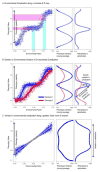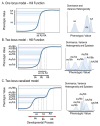The developmental-genetics of canalization
- PMID: 29782925
- PMCID: PMC6251770
- DOI: 10.1016/j.semcdb.2018.05.019
The developmental-genetics of canalization
Abstract
Canalization, or robustness to genetic or environmental perturbations, is fundamental to complex organisms. While there is strong evidence for canalization as an evolved property that varies among genotypes, the developmental and genetic mechanisms that produce this phenomenon are very poorly understood. For evolutionary biology, understanding how canalization arises is important because, by modulating the phenotypic variation that arises in response to genetic differences, canalization is a determinant of evolvability. For genetics of disease in humans and for economically important traits in agriculture, this subject is important because canalization is a potentially significant cause of missing heritability that confounds genomic prediction of phenotypes. We review the major lines of thought on the developmental-genetic basis for canalization. These fall into two groups. One proposes specific evolved molecular mechanisms while the other deals with robustness or canalization as a more general feature of development. These explanations for canalization are not mutually exclusive and they overlap in several ways. General explanations for canalization are more likely to involve emergent features of development than specific molecular mechanisms. Disentangling these explanations is also complicated by differences in perspectives between genetics and developmental biology. Understanding canalization at a mechanistic level will require conceptual and methodological approaches that integrate quantitative genetics and developmental biology.
Keywords: Canalization; Epistasis; Genotype-phenotype maps; Nonlinearity; Robustness.
Copyright © 2018 Elsevier Ltd. All rights reserved.
Conflict of interest statement
Figures






References
-
- Waddington CH. The canalisation of development and the inheritance of acquired characters. Nature. 1942;150:563.
-
- Waddington CH. Selection of the genetic basis for an acquired character. Nature. 1952;169(4302):625–6. - PubMed
-
- Waddington CH. The genetic assimilation of an acquired character. Evolution. 1953;7:118–126.
-
- Waddington CH. On a case of quantitative inheritence on either side of the wild-type. Z in Abstammungs u Vererb Lehre. 1955;87:208–28. - PubMed
-
- Waddington CH. Genetic assimilation of the bithorax phenotype. Evolution. 1956;10:1–13.
Publication types
MeSH terms
Grants and funding
LinkOut - more resources
Full Text Sources
Other Literature Sources

